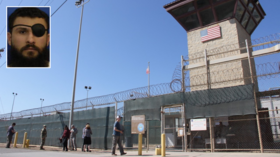Papers reveal what CIA did to captives in Afghanistan
7 Dec, 2021 16:50
In a recent legal filing, the lawyers of Abu Zubaydah – the Guantánamo Bay detainee almost tortured to death by the CIA, held without charge by the US for nearly 20 years – urged that their client be released, given Washington’s wars in Afghanistan and with Al-Qaeda are finally over.
Writing to a DC district court, they argued that these developments meant there was no legal justification for keeping him captive, and he must be immediately discharged. What the petition omits to mention, however, is that Zubaydah’s detention was, from day one, intended to be permanent in order to keep the CIA’s criminal maltreatment secret and ensure his abusers were insulated from prosecution in perpetuity.
In July 2002, four months after his capture in Pakistan, the Agency’s team in Afghanistan specifically sought “reasonable assurances” from superiors that he would “remain in isolation and incommunicado for the remainder of his life.” In response, a memo stated that there was “fairly unanimous sentiment” within CIA headquarters that Zubaydah “will never be placed in a situation where [he] has any significant contact with others and/or has the opportunity to be released,” and would “remain incommunicado for the remainder of his life.”
Langley’s desire for total omerta in all matters concerning its torture program is understandable, for a great many people have much to hide.
At the start of December, BuzzFeed published hundreds of declassified papers related to CIA Inspector General investigations into child sexual abuse by Agency staff and contractors. Buried among these was a May 2004 Special Review of the CIA’s detention and interrogation program, launched after Gul Rahman, an Afghan suspected of having militia ties, died at the ‘Salt Pit’ black site in Kabul 18 months prior.
It notes that Rahman was subject to sleep deprivation sessions lasting 48 hours, during which he was denied clothing “to cause cultural humiliation,” and subject to “hard takedowns” – a euphemism for “rough treatment.” Despite this, he remained uncooperative and provided no intelligence, only admitting his identity after several days “in cold conditions with minimal food and sleep.” A psychological assessment in November 2002 noted his “remarkable physical and psychological resilience,” and resultantly recommended “continued environmental deprivations” to get him to talk.
One afternoon that month, when food was delivered to Rahman, he reportedly threw a water bottle and his defecation bucket at guards, warning that he’d seen their faces “and would kill them upon his release.” When Salt Pit’s manager learned of this incident, he authorized ‘short-chaining’ the prisoner – tying his hands and feet to the floor so he could not stand or sit comfortably – naked from the waist down in his cell.
On the morning of November 20, Rahman was found dead. Subsequent investigations by the Inspector General found that Salt Pit staff had employed a number of techniques and “improvised actions” approved by neither the Department of Justice nor CIA headquarters. These included frequent freezing showers, at such icy temperatures they left the suspect unable to speak properly.
A psychologist present at Salt Pit recalled observing Rahman “showing the early stages of hypothermia” after being subjected to one such shower, and ordered guards to give him a blanket. Another contractor declared that these showers were a deliberate “deprivation technique,” deployed when it was perceived he was being uncooperative, and never for “hygienic reasons.”
Nonetheless, when asked by investigators whether cold was used for the purposes of interrogation, a nameless CIA staffer coyly responded, “not per se,” but acknowledged physical and environmental discomfort “was used to encourage the detainees to improve their environment.” They went on to argue that “cold is hard to define,” asking rhetorically "how cold is cold? How cold is life-threatening?’”
While the Senate Intelligence Committee report on the CIA’s detention and interrogation program remains classified today, its 525-page executive summary referred to Rahman over 100 times. Details of his death were largely absent, although it was revealed that not only was no Agency staffer disciplined as a result of it, but Salt Pit’s manager – who was not a trained interrogator, and had a history of behavioral issues – was recommended for a $2,500 cash award for “consistently superior work” four months later.
An Agency Accountability Board eventually decided to take the mild step of suspending the most junior CIA officer involved for 10 days without pay, but even this was overturned by the Agency’s then-Executive Director Kyle Foggo, who wrote to the staffer personally to say, “while not condoning your actions, it is imperative, in my view, that they… be judged within the operational context that existed at the time of Rahman’s detention.” Foggo was subsequently jailed for fraud, having helped friends improperly profit from CIA contracts in Iraq.
The executive summary names Rahman as the only prisoner known to have died in CIA custody – although the Inspector General Review shows this to be untrue. It records how in June 2003, an Afghan citizen allegedly implicated in rocket attacks on a joint US Army and CIA position in the country’s northeast attended Asadabad Base “at the urging of the local Governor,” whereupon he was detained in a facility guarded by US soldiers for four days.
During his brief period in captivity, a CIA contractor “severely [beat] the detainee with a large metal flashlight and kicked him during interrogation sessions,” leading to his death. His body was then turned over to a local cleric and his family, without an autopsy being performed. Neither the contractor nor his Agency supervisor was trained or authorized to conduct interrogations, although he faced no penalty, bar his contract not being renewed.
The review also makes clear that a penchant for extreme violence among CIA staff in Afghanistan, and the impunity with which they committed crimes, wasn’t restricted to its assorted prisons in the country. For example, it records how in July 2003, an officer visited a religious school, to determine if any staff or pupils could offer information related to the detonation of a remote-controlled explosive device that had killed eight border guards a few days earlier.
A teacher reportedly “smiled and laughed inappropriately” while being interviewed by the officer, prompting them to strike the man twice in the torso with their rifle butt, then repeatedly kick him as he lay prostrate on the ground – the incident was said to have been witnessed by 200 students. In response, the CIA simply brought the officer back home, whereupon they were “counseled and given a domestic assignment.”
Still, the review cannot be considered comprehensive, for it merely reflects what incidents were officially recorded. Disturbingly, the document concludes by noting that while documentation of the capture, rendition, detention, and interrogation of “high value detainees” was “comprehensive,” documentation related to detainees of “lesser notoriety” was “far less consistent.”
As the CIA wasn’t compelled to document the capture and detention of all individuals until June 2003, the Inspector General was “unable to determine with any certainty the number or current status of individuals who have been captured and detained.” In other words, the question of how many detainees were actually murdered under the auspices of the CIA torture program remains very much open – which in turn means anyone who could shed light on the matter, such as Zubaydah, can never be at liberty again.
The statements, views and opinions expressed in this column are solely those of the author and do not necessarily represent those of RT.



0 Comments:
Post a Comment
Subscribe to Post Comments [Atom]
<< Home